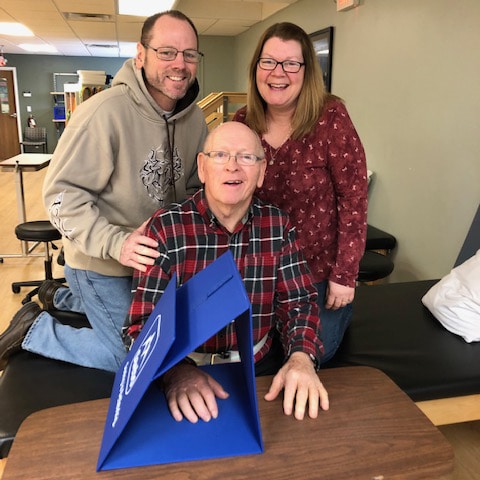Stroke Survivor Gives His First Thumbs Up!

Stroke survivor give his first thumbs up! ….and owes a part of his success to Mirror Box therapy!
Coy’s life before his stroke on December 2, 2018, was fun and fulfilling. He gathered regularly with friends and family, was a talented fast-talking auctioneer, traveled all over to tractor shows, and raised family of goats on a small farm. Like many other stroke survivors, Coy’s stroke caused his right dominant arm and hand to be almost entirely paralyzed. He also struggled to pay attention to his affected side—a very common yet disabling condition that can be a safety concern and interferes with regaining use of the weaker side.
As an occupational therapist, I help people like Coy regain function of their arm, work on impaired areas of the mind and body, and restore life skills after having a stroke. When I first met Coy and his supportive family, I knew we ALL needed to get to work to make sure Coy could take advantage of every rehabilitation technique possible to optimize his chances for recovery.
When someone is unable to move their arm after a stroke, one of the first-line evidence-based interventions a clinician should be having their client do is learn how to do a mirror therapy program. Mirror therapy works by having the stroke survivor’s affected arm placed behind a mirror so they cannot see it. The survivor watches the reflection of their unaffected side in the mirror performing familiar, functional movements while they try to make the same movements at the same time with their affected side. Mirror therapy activates “premotor” areas of the brain that help plan movement. Premotor neurons housed in this region are known to be important for recovery of motor function after stroke. What this means is that just watching mirrored hand movement activates the brain similar to actual movement! New neural connections can form in the damaged part of the brain using this “jump start” provided by the mirror therapy.
While at first, it might seem like just a gimmick, in reality, this is a fascinating neuroscience rehab tool that has been proven in research but is vastly underutilized in conventional therapy centers! I have been asking my clients to commit to daily use of mirror therapy long before Saebo’s Mirror Box launched in February. Why spend time doing something that you may not physically see immediately changing? It is because motor planning is critical to happen for movement to initiate - especially skilled movement. Some survivors just need more time (i.e. more neural priming using the mirror box) than others! That’s why I made sure Coy and his family know that mirror therapy is one of several important rehab pathways that could help him recover faster.
I told him to try to do it at least 5 times per week for about 30 minutes, and I gave him some tasks to do with his hand. In early February, Coy’s family made him their own “do-it-yourself” mirror box. In a pinch, his DIY box did the trick, but he still needed more direction and a better way to keep his attention. Once he received a Saebo Mirror Box, his training kicked up a notch! The excitement of the well-designed box, following along with Saebo’s suggested exercise protocol with interesting activities, and having fun with a personalized playlist of music done to each set of exercises all contributed to more enjoyment along his rehabilitation journey for the “comeback” of his upper limb.
Shortly after starting mirror therapy with the Saebo Mirror Box in my clinic and at home, Coy’s once flaccid hand showed a positive breakthrough: he could lift up his thumb! Not just once, but several times! The Mirror Box had to have been one of the jumper cables! Coy and his family are now starting to see more sparks ignite in his arm and hand. He is now able to more successfully grip his walker in his right affected hand. He is also able to pull his arm out of a sleeve, partially bend his elbow to reach for a door handle, and slide his arm across the counter to get a snack. He is paying more attention to his affected side and also has more confidence. All of these small steps are amounting to big changes. They are also contributing to his growing personal optimism and outlook in his recovery.
I don’t see that Coy’s progress is going to slow down any time soon, and I’ll be sure to keep you posted on how he is doing in future announcements. Stroke survivors…the way I see it, just like Coy, HOPE IS ON THE HORIZON for you any day now! As with so many things in life that take dedicated commitment before you see it pay off, mirror therapy is no exception. I am thankful that through the new launch and promotion of the Saebo Mirror Box, the rehab community is acknowledging that mirror therapy is a valuable restorative approach rooted in neuroscience principles. Mirror therapy should be utilized by clinicians and stroke survivors throughout the continuum of care as an essential tool not to be overlooked.
Stroke Survivors…I want you to See it. Believe it. Achieve it using mirror therapy. Share the same spirit of my client Coy by giving a thumb’s up with him, proclaiming there is NO PLATEAU IN SIGHT!
- Emily J. Morgan, MS, OTRL, CSRS, CBIS, RPSFC in NDT Lead Occupational Therapist and Supervisor and Ascension Genesys Ambulatory
All content provided on this blog is for informational purposes only and is not intended to be a substitute for professional medical advice, diagnosis, or treatment. Always seek the advice of your physician or other qualified health providers with any questions you may have regarding a medical condition. If you think you may have a medical emergency, call your doctor or 911 immediately. Reliance on any information provided by the Saebo website is solely at your own risk.



